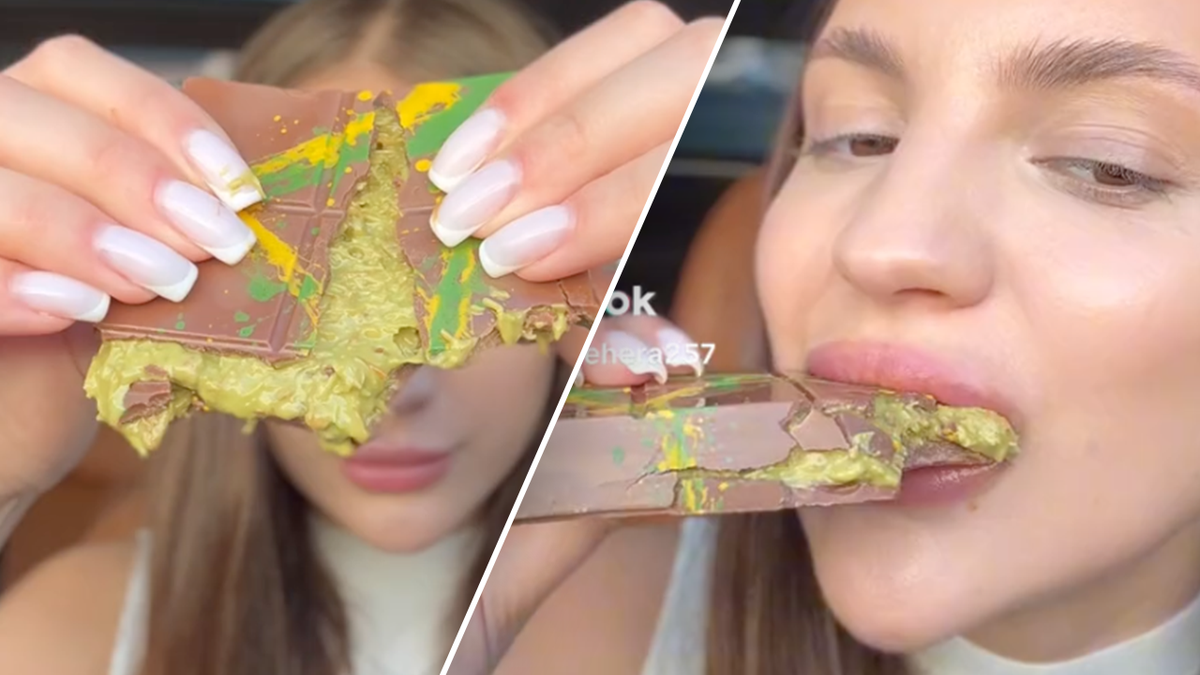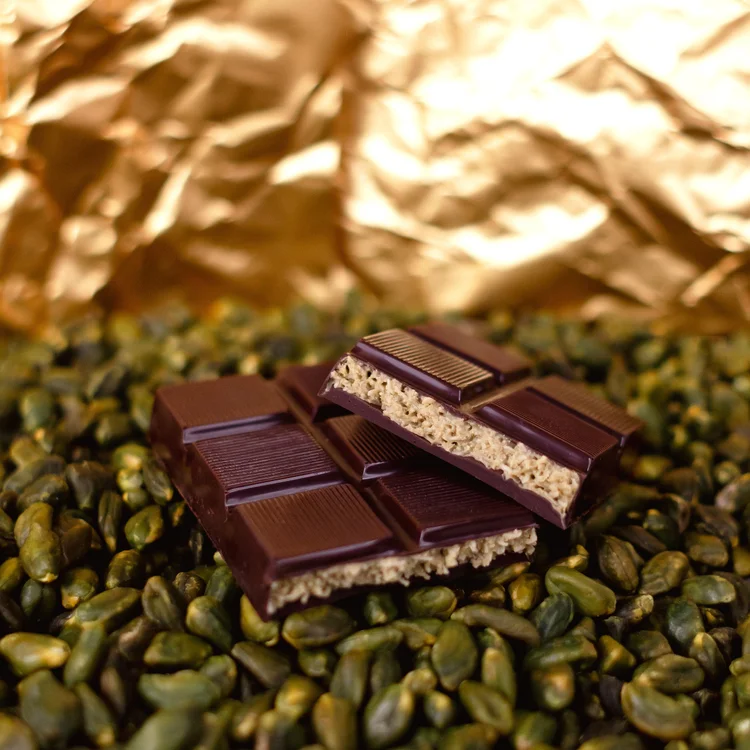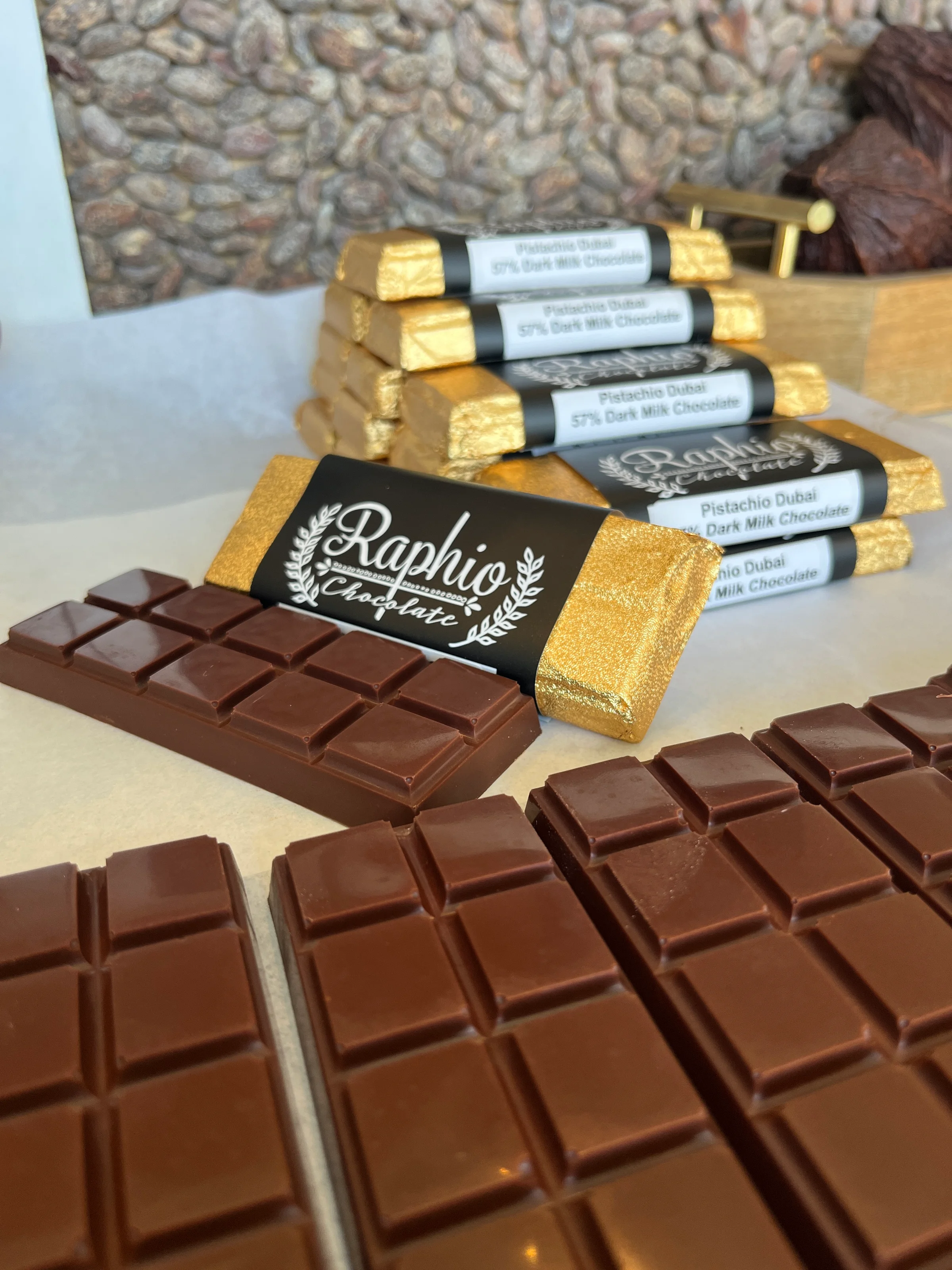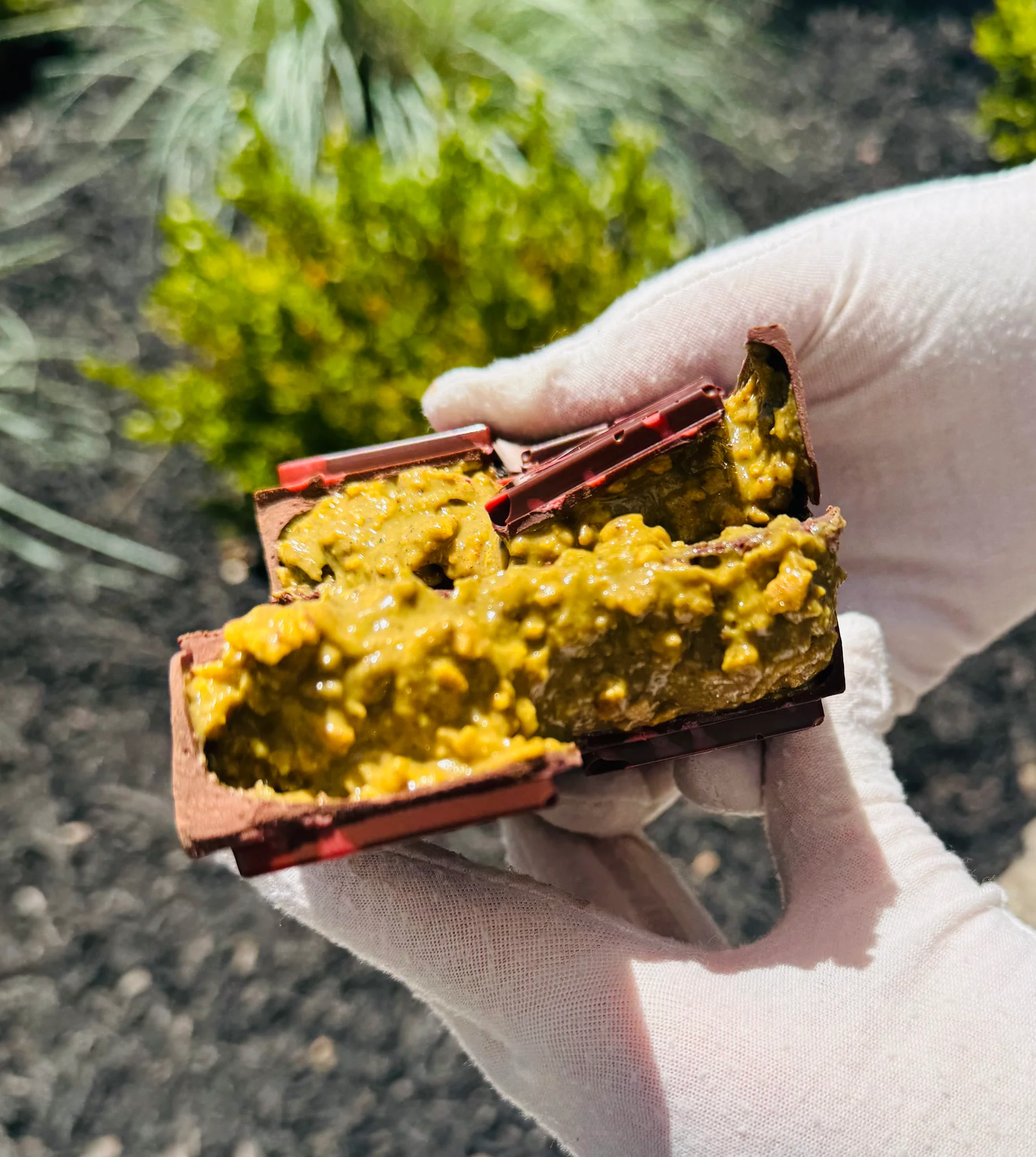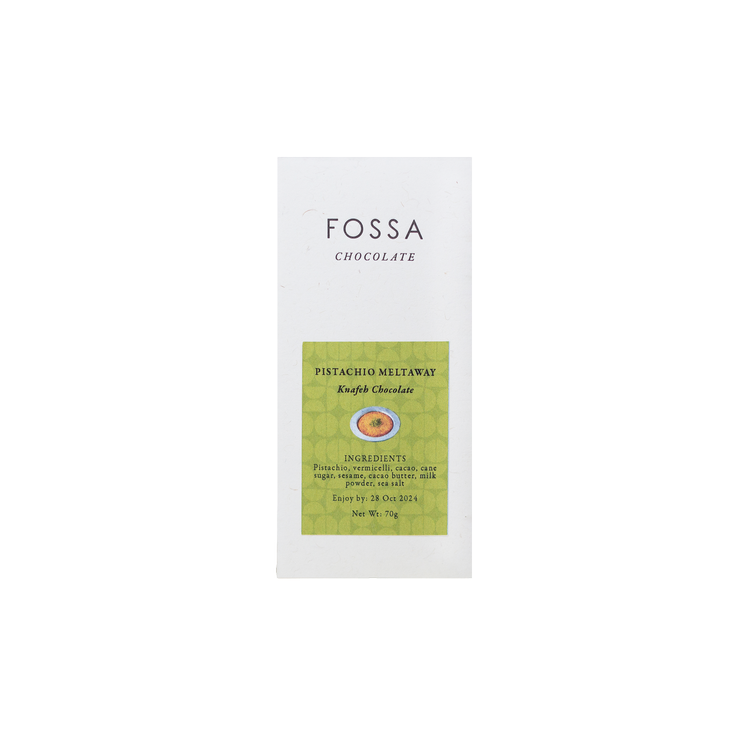Why Dubai Chocolate Went Viral and What It Reveals About Food Marketing Today
- Caterina Gallo
- Aug 31
- 9 min read
Updated: Sep 12

Introduction
A name that, in just a couple of years, has become shorthand for one of the most viral food phenomena of the decade. If you’ve been on TikTok, Instagram, or YouTube since 2022, chances are you’ve seen it: a glossy bar that cracks open to reveal a gooey, neon-green pistachio center, dripping with tahini, kadaif (shredded filo pastry), and often crowned with gold dust. It’s a filled milk chocolate bar made for cameras, for the slow, indulgent cutting, for the messy bite, for the gasp of influencers showing off their exclusive treat.
But how did this bar, born as a niche creation in Dubai, turn into an international obsession? Why were consumers suddenly willing to pay $20, $50, even $100 for what, in most cases, amounts to a candy bar with poor-quality ingredients and loaded with sugar? And why did the Dubai Chocolate bar, above so many other creative confections, become a global craze?
My position is clear: Dubai Chocolate is not inherently problematic as an idea. A filled bar with pistachio and tahini can be interesting, even delicious, and curiosity around new formats is natural. I don’t oppose small chocolate makers who recreate it. In fact, when reinterpreted with integrity and better ingredients, it can become something of value. What I question is the system that turned this "treat" into a frenzy: a system of viral content, manipulative marketing, and consumer conditioning that I define as Bulimic Marketing.
This is not about flavor, but about spectacle. Not about taste, but about performance. And if we want to understand not just Dubai Chocolate, but the future of food culture itself, we need to look closely at how this phenomenon was created, who profited, and what it reveals about the way we eat in the 21st century.
Origins of Dubai Chocolate
The official story of Dubai Chocolate has been told many times. In 2021, Sarah Hamouda, a British-Egyptian engineer living in Dubai, began experimenting with flavors to satisfy her cravings during pregnancy. With her husband Haris Ali, she partnered with pastry chef Nouel Catis Omamalin to reimagine knafeh: the classic Middle Eastern dessert that combines pistachio, tahini, and kadaif. Their creation, branded under Fix Dessert Chocolatier, was launched as “Can’t Get Knafeh of It”.

It was positioned from the start as an exclusive product. At roughly £16 ($20) per piece, restricted to one per customer per week, and available only through Deliveroo in Dubai and Abu Dhabi, it wasn’t designed for mass consumption. It was designed for status. Sometimes dusted with edible gold, always dripping with green filling, it was a product that looked spectacular on camera, and that was the point.
The international press picked it up. Influencers staged dramatic cuts and bites for TikTok, creating a cascade of reposts and reactions. Tourists brought bars home as trophies. Within months, Dubai Chocolate had become not a recipe, but a phenomenon.
The Hidden Story: Who Really Created It?
Yet behind this glossy narrative lies another story that exposes the darker side of food trends. As Mark Ocampo, co-founder of Auro Chocolate in the Philippines, revealed:
“The chef we worked with, Nouel Catis, who is Filipino, is the actual creator of the original product. They actually co-registered the product when they first started. Sarah Hamouda was never a chef, and the Filipino chef who had originally created the recipe had been making it since before Fix became famous. When it did, she cut him out and never gave him the credit. He wasn’t even asking her for money, just an acknowledgement that he, in fact, created it. However, she never did, which is why we now produce it with him. As the creator originally intended. It’s a sad story of colonialism. They use the minority.”

This is not a minor footnote. It highlights a recurring pattern in food culture: appropriation, erasure, and rebranding. While the international media celebrated Dubai as the birthplace of a luxury chocolate craze, the Filipino chef who originally created the recipe was erased from the story. His work was exploited, his credit denied. And when Auro decided to work directly with him, it wasn’t just about chocolate; it was about restoring dignity and visibility.
The irony is bitter: a bar sold as “luxury” in Dubai, tied to the imagery of exclusivity, was built on the invisibility of a minority creator. This is why origins matter. Not because consumers care who first added pistachio to chocolate, but because narratives of credit and exploitation reveal how viral food phenomena often reproduce the same dynamics of colonialism that chocolate itself has carried for centuries.
Dubai as a Brand, Not an Origin
One of the striking facts about Dubai Chocolate is that it isn’t “from Dubai” in any authentic sense. Unlike single-origin chocolate, which is tied to terroir, genetics, and farming practices, this bar has no distinct agricultural identity. Its ingredients — pistachio, tahini, kadaif — are broadly Middle Eastern, not specifically Emirati. So why call it Dubai Chocolate? The answer is marketing.
Over the last three decades, Dubai has positioned itself as a global luxury hub. From skyscrapers and shopping malls to fine dining and luxury tourism, the city has become shorthand for extravagance. By attaching “Dubai” to the chocolate, the brand leveraged that reputation: consumers weren’t just buying a chocolate bar, they were buying into Dubai’s image of opulence.
This branding decision reveals an important truth: the Dubai Chocolate phenomenon was never about culinary tradition. It was about spectacle, exclusivity, and the promise of status.
How TikTok and Social Media Created the Craze
If Dubai Chocolate had stayed on Deliveroo, it might have remained a local curiosity. What transformed it into a global obsession was TikTok.
The power of the bite
The format was simple but irresistible: oversized bars, glossy coatings, gooey fillings that spilled out on camera. Creators staged exaggerated bites — without even swallowing — because the performance, not the flavor, was what generated views.
ASMR elements (such as the crunch, the drip, and the squish) amplified the effect. The bar wasn’t designed to be savored; it was designed to look and sound irresistible. And in the logic of TikTok, where seconds of spectacle determine virality, this product was perfect.
From curiosity to compulsive loop
Psychologists refer to it as the bliss point: the combination of sugar, fat, and salt optimized to trigger cravings. Dubai Chocolate embodied that principle, but more importantly, it was performed at the bliss point.
Watching bite after bite created a cycle:
Watch → Crave → Buy → Repeat.
Consumers didn’t just want to taste it. They wanted to be part of the performance. To film themselves cutting, biting, and dripping. To show that they too had access to the bar everyone else was watching.
Replication and the Candy Bar Avalanche
Once the formula proved viral, replication was inevitable. Cafés, supermarkets, and even multinational corporations rushed to produce their versions. Pancakes, gelato, croissants, spreads, and discount-store imitations appeared. Resellers charged up to $100 per bar.
The result? The original exclusivity collapsed, but the obsession only grew. The very abundance of copies created scarcity in another form: the scarcity of authenticity. Consumers rushed to secure “the real one” or at least a version they could film.
But most of these reproductions had little to do with quality. They were candy bars, heavy with sugar and fats, often made with compound chocolate and poor nutritional balance. Consumers who balk at the price of a high-quality single-origin chocolate lined up to pay premiums for glorified junk.
The Pistachio Problem: How a Viral Bar Disrupted Global Supply
The Dubai Chocolate viral sensation did not just reshape consumer behavior online; it had very real consequences for agricultural supply chains, particularly for pistachios. What was once simply an ingredient in regional desserts became a commodity under siege, its availability squeezed by a sudden and unsustainable surge in demand.
A global shortage emerges
By mid-2024, reports began to surface of unusual pressures in the pistachio market. Prices surged from $7.65 to over $10 per pound in less than a year, while the availability of shelled pistachios in the United States — the world’s largest producer — dropped by nearly 20% between February 2024 and February 2025. This was not just a seasonal fluctuation. It was a structural disruption triggered by a viral dessert that demanded pistachios in every form: fillings, spreads, toppings, gelato, pancakes, croissants, and even supermarket candy imitations.
Demand from Dubai ripples outward
The United Arab Emirates became a central hub of this demand. Iranian exports of pistachios to the UAE increased by over 40% in just six months, reflecting the rapid redirection of supply chains to meet the TikTok-driven surge in demand. This wasn’t organic consumer growth; it was market demand manufactured by virality and amplified by resellers eager to capitalize on the opportunity.
Contributing factors: bad harvests and market panic
The situation was aggravated by poor U.S. harvests in 2024, much of which was sold in-shell, further reducing availability for processors and chocolatiers. Fearing scarcity, cafés and retailers worldwide began stockpiling pistachios to secure their own Dubai-style products, fueling a feedback loop of shortage and rising costs.
Consequences for businesses and sustainability
The ripple effects were significant:
Artisan chocolatiers and bakeries faced delivery delays and soaring ingredient prices.
Supermarkets and chains in some regions even rationed Dubai Chocolate-style products.
Environmental costs have grown sharper since pistachio farming is water-intensive, especially in California and Iran, where resources are already fragile.
From food trend to supply chain stress
Ultimately, a dessert designed for spectacle disrupted an entire agricultural supply chain. Pistachios — once a relatively stable crop — became a case study in how quickly TikTok trends can destabilize markets, driving scarcity and ecological strain. The irony is striking:
A bar that was never about authentic origin or terroir managed to reshape the fate of a crop halfway across the world.
The Lindt Case: Outrage and Amnesia
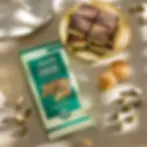
The Dubai Chocolate mania also reveals how short consumer memory can be. Not long before releasing their own “Dubai bar,” Lindt was caught in a scandal: the company was forced to admit that its “Excellence” branding was misleading, and not all products deserved the label. Outrage erupted on social media. Consumers denounced the deception, criticized the brand, and publicly called it out. And yet, only weeks later, Lindt launched its Dubai Chocolate. The same consumers who had condemned the brand were now queuing to buy it. This paradox illustrates one of the central themes of modern marketing: outrage is temporary, but hype is profitable. Consumers tend to forget scandals quickly when the new fad appears. Manipulation is simple when memory is short.
What Dubai Chocolate Reveals About Modern Food Marketing
Dubai Chocolate is not a problem because of its recipe. It is a problem because of what it represents: the fusion of viral content, manipulative branding, and consumer conditioning.
Bulimic Marketing

This is where I introduce the concept of Bulimic Marketing. Like bulimia, where bingeing is followed by purging, Bulimic Marketing is built on cycles of excess without nourishment.
TikTok creators binge-bite without swallowing. Consumers binge-watch without tasting. The loop isn’t about enjoyment but about endless craving.
This model doesn’t celebrate food. It exploits it. It doesn’t educate consumers. It manipulates them into compulsive desire. And when companies collaborate with creators who use these formats, they reinforce an economy of unhealthy relationships with food.
Why education alone isn’t enough
Some argue that the solution is education, teaching people about better choices, adding labels, and offering alternatives. But awareness campaigns have existed for decades, and obesity and eating disorders continue to rise. Why?
Because awareness is drowned out by the noise of virality.
A post about moderation is invisible compared to a million-view video of an oversized chocolate bite. When platforms reward binge behavior, education alone cannot compete.
Impact on Craft Chocolate
For craft makers, Dubai Chocolate presents a dilemma. On the one hand, consumers demand it. Ignoring the trend could mean losing customers. On the other hand, participating in the madness risks associating their brand with hype rather than integrity. Many small makers have chosen to reinterpret the bar on their own terms: using real chocolate, ethically sourced ingredients, and balanced recipes. In these cases, the bar becomes less about spectacle and more about creativity. However, the fact remains that the demand was generated not by an appreciation of flavor, but by viral content.
This is the deeper tragedy. While fine-flavor chocolate remains a niche product, struggling to reach mainstream consumers, the latter are willing to pay premiums for sugar-heavy imitations simply because they’ve been conditioned to desire them.
Conclusion
Dubai Chocolate is a case study in how food culture is shaped by spectacle, marketing, and manipulation.
It was born from appropriation and erasure, where the true creator was denied credit.
It became viral not through its flavor but through TikTok performances of binge eating.
It was replicated endlessly, stripped of authenticity, and commodified at every level.
It exposed consumer amnesia, as in the Lindt case, where outrage was forgotten overnight.
It revealed the mechanics of what I call Bulimic Marketing: a system that exploits cravings, not taste.
The lesson is not to reject Dubai Chocolate as an idea, nor to criticize those who are curious to taste it. The lesson is to recognize how easily desire is manufactured and to question the systems that condition our cravings. I firmly believe that without the staged bites, the drip videos, and the hype-driven performance, Dubai Chocolate would have been just another filled bar. Instead, it became a global obsession.
So the question remains:
Would we still crave it if nobody staged it for the camera?












